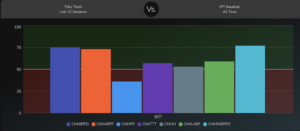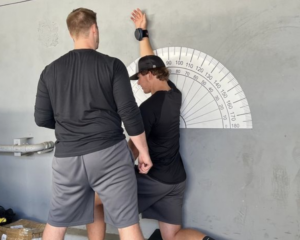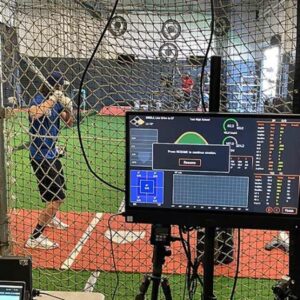A Daily Dose: How KPI’s System Gives Athletes an Assessment Everyday
“Assessments” are the new buzzword in the athlete training world. Providing an assessment to individually evaluate an athlete is an extremely important part of the process and one we take very seriously at KPI. Unfortunately, most training systems just provide an assessment and then they do not do much with the information or they do not have a way to reassess the athlete to ensure real time decisions can be made to reflect changes and adaptations in the athlete. At KPI, we have created a system that provides an assessment every time an athlete goes through a Development Program session and allows the coaching staff to constantly evaluate each athlete’s progress and adjust programming accordingly.
The Daily Strength Assessment
Every session at KPI starts with a carefully crafted warm-up that is based on the mobility screen the athlete received during their initial assessment. After their warmup, every athlete jumps on our Hawkin Dynamics force plates. This is the most important part of our program and we use each athlete’s jump profile in a very unique way. Very few performance facilities have force plates, and most of those that do perform the simple task of just using peak force output for the force plate data and programming. At KPI, we take a much more nuanced approach to this daily assessment, as we have created a system that evaluates the Central Nervous System movement bias and we basically aggressively train the deficiency the athlete displays. This is extremely valuable for a few reasons…
- It’s About Way More Than Force – most high level athletes already do a really good job of producing force (that’s why they are high level). So just evaluating and using Peak Force as the base for programming is not providing the athlete what they truly need, it could actually be increasing their chance of injury. If an athlete is being trained to produce force and they are deficient in other areas, they are accentuating the imbalance in their Central Nervous System and that can potentially lead to injury.
- Adjusting Programming in Real Time – With the athletes jumping daily, and our coaching staff constantly checking their jump profiles, we are able to evaluate their stress levels and adjust programming in real time. It is common place for us to proactively check an athletes jump profile and back off of heavy training with them because their force plate data is displaying signs of stress in their bodies. This is one of the main reasons we keep the athletes so healthy at KPI.
- Evaluating Program Over Long Periods of Time – Over time the force plate data allows us evaluate the adaptations the athlete is making to their training and we can change their programming to ensure their CNS is always being challenged and improved. Training is so much more than producing peak force, it is about addressing deficiencies and constant improvement. As the athlete adapts to their training and their CNS changes, we are able to adjust their training and constantly drive their progress forward.

The Daily Pitching Assessment
Every time a pitcher attends a session at KPI we are providing them an assessment that evaluates the values we hold in the highest regard. Using our partnership with armcare.com, we use sensors to evaluate the range of motion and strength levels of each pitcher, every day. We use that information in a multitude of ways…
- Range of Motion Balancing – We want each pitcher to have balance in their throwing arm between shoulder internal and external rotation. Any in-balance can lead to potential injuries. With our daily assessment of each pitcher, we are able to evaluate on the spot if there is a ROM deficiency. As soon as we identify a deficiency that falls outside of our acceptable levels, we are able to program the pitcher, in real time, with a protocol that will improve the lack of balance they are displaying. This ensures the pitcher is receiving programming that will help their unique needs as a high level thrower.
- Strength Balancing – We want our pitchers to be strong in their throwing arms, because a lack of strength is the cause for most arm injuries. We use our arm care sensors to evaluate the throwing arm’s strength levels in comparison to their body weight. If we see that a pitcher is lacking strength we can either program them in a more specific strength routine based on their arm care assessment, or we can prioritize recovery and lower throwing stress/volume to allow the throwing arm to return to its normal strength level.
- Grip Strength – We measure grip strength a very specific way at KPI. Most normal grip strength tests measures muscles that do not directly correlate with arm health. The position and manner we test grip strength in allows us to evaluate the forearm flexors around the UCL, the ligament most commonly injured and the one repaired in Tommy John surgery. By isolating and evaluating grip strength in this way, we can proactively determine if the area around the elbow joint is strong or showing signs of fatigue.
We also use our 2 Trackman units to measure pitch design goals every time a pitcher throws their weekly bullpen. The pitching staff monitors each pitchers spin rate, movement patterns, and approach angles (amongst many things) and will adjust their drill work and pitch design goals based on the data we collect each week.

The Daily Hitting Assessment
We take our hitting just as serious as we take our pitching, and our robust hitting program provides daily data to evaluate and use to improve hitters. The 3 main ways we use session data to provide an assessment are listed below…
- Bat Speed – Bat Speed is a huge part of our training of hitters. Each hitter that goes through a session at KPI uses bat speed swing trainers and is provided data on their bat speed using Blast bat sensors. They also receive a visual mph reading while they use our weighted swing trainers. This feedback provides them, and us, real time data on their bat speed progress.
- Blast Metrics – We have built our entire hitting program around the concept that we want to collect data on every swing and be able to constantly monitor progress using this data. The hitters at KPI wear their sensors for every swing in our facility and we use that data to run reports and adjust programming. Every hitting session at KPI provides us with dozens of swings to use as a daily assessment.
- Batted Ball Data – The beauty of the KPI system is the checks and balances to ensure the programming is always working. With our Hittrax hitting simulator, we are able to ensure our approach with Bat Speed and Blast is leading to improvements in the batted ball metrics we value the most and correlate the strongest with on-field performance. We analyze this data weekly and adjust swing programming accordingly to ensure each hitter is getting exactly what they need.

While initial and periodic assessments are important in the development of athletes, the daily assessment is the most important part of the process. Using our incredible technology and well-planned systems, we have created an environment that provides every athlete at KPI a daily assessment that allows us to constantly monitor and adjust to each athlete. There is too much on the line for the young athletes that train with us for us not to ensure they are constantly getting the most effective programming in the industry. We can’t rely on the old way of doing things, we have to help the young men and women in our facility achieve their dreams.


